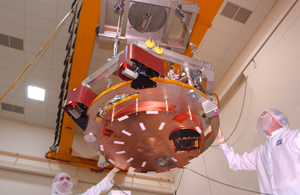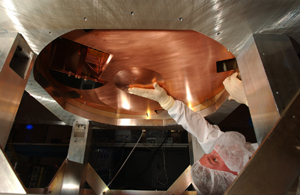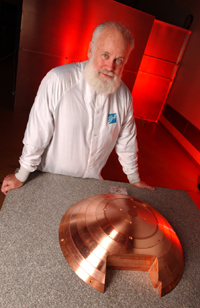June 29, 2005
FOR IMMEDIATE RELEASE
NEW YORK, NY— There will be more than fireworks exploding in the sky this Fourth of July. While most Americans enjoy local parades, backyard barbecues and the company of friends, NASA will be blasting open a comet far out in space, hoping to uncover valuable information about the nature and origins of the solar system.
One of mankind's oldest metals will play an integral role in this unusual space mission. NASA scientists will deploy a copper-topped probe to excavate a sizeable hole in the comet so they can examine its contents.
 Deep Impact spacecraft prior to assembly with copper cratering mass exposed.
Deep Impact spacecraft prior to assembly with copper cratering mass exposed.high-resolution version of this photo.
[Image courtesy of Ball Aerospace & Technologies Corp.]
After 173 days in space chasing Comet Tempel 1, which is whizzing through our solar system at 6.3 miles per second, NASA's Deep Impact spacecraft will get close enough to the comet during the early hours of July 3 to release a probe called an "impactor."
NASA will guide the barrel-sized impactor toward the comet until two hours before impact. At that point, the device's automated navigation system will take over, directing the probe on its final collision course with the comet's nucleus at 1:52 a.m. EDT on July 4 (10:52 p.m. PDT on July 3).
Lacking any explosive charge, the mass of the 816 lb. impactor, combined with the velocity at which it is traveling, is expected to carve out a crater that could range in size from a large truck to the length of a football field.
Copper, which makes up half of the impactor's total mass, was selected for this mission based on several key factors including its overall strength - necessary if the probe is to crack open the comet's surface. To make the copper probe even stronger, the metal was fortified with 3 percent beryllium.
 Technician inspects copper-topped Deep Impact Impactor.
Technician inspects copper-topped Deep Impact Impactor.high-resolution version of this photo.
[Image courtesy of Ball Aerospace & Technologies Corp.]
Another important reason copper was selected is its molecular structure. Copper reacts slowly with other elements such as oxygen, which will be released by the comet after the collision. This means that scientists will be better able to see the comet's vaporized contents because copper emissions won't obscure them.
When the collision occurs, the Deep Impact spacecraft that carried the probe into space will spend approximately 13 minutes taking photographic images and collecting data from a distance of 310 miles below the collision. After that, a blizzard of fallout from the comet is expected to block its view.
 Dr. Michael F. A'Hearn, University of Maryland astronomer, with the Deep Impact copper cratering mass.
Dr. Michael F. A'Hearn, University of Maryland astronomer, with the Deep Impact copper cratering mass.High-resolution version of this photo.
[Image courtesy of Ball Aerospace & Technologies Corp.]
A camera on the impactor will capture its final moments before it crashes into the comet. NASA will also use the Hubble Telescope to analyze debris from the comet.
"The last 24 hours of the impactor's life should provide the most spectacular data in the history of cometary science," said Michael A'Hearn, the Deep Impact Principal Investigator. "With the information we receive after the impact, it will be a whole new ballgame. We know so little about the structure of cometary nuclei that almost every moment we expect to learn something new."
Discovered over 10,000 years ago on earth, copper is prized for its beauty, strength, durability and ability to be combined or "alloyed" with other metals to create new metals like brass and bronze.
Copper, in its pure or alloyed form, is an indispensable material used by such groups as NASA and the U.S. military and manufacturers in various industries including: appliances, computer technology, mobile phones, wind and solar energy, plumbing tube, building construction and interior design.
###
